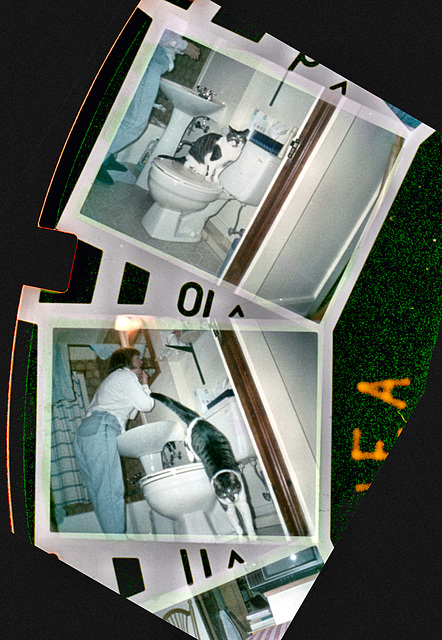A and M, Redscale
Reunion
First columbine
Kelly
One night, after a drink
The cat wonders what I am at
My 1995 visit to Toronto
Bitter cress and a lot of other names
Gone bananas
Bubbly day
Believe it or not
Starling on an apple bough
Keep the inside of the chimney clean, it says
Liverworts and mosses, frisky
Reports of his death were premature
Arctic blue, a.k.a. Newfoundland Blue, butterfly
Seen one, seen 'em all.
I didn't dare remove any golf balls
Blue jays flyin' in the rain
Dandy Long Legs
Bumblebee
Walking past a muddy puddle
Some friends of ours
New Moon setting
Frost heave
When focus is not as critical
Just overexposed, thassall!
Mother preening her young
Three-Way Switch Drawing
Saturday night sky
White-crowned sparrow
Spring snow
Squill or Scilla, whatever
Kalmia leafing out
Batmobile masquerading as iceberg
Moss in my pot
Iceberg about five km from my door
My father in 1994, at 83
The Rose in the harbour, 1995
Duff's Supermarket
Neighbourhood tom eyeing me
One more blue jay picture
Seed leaves and true leaves
Pffft. It's not *that* big.
European starling
See also...
Keywords
Authorizations, license
-
Visible by: Everyone -
All rights reserved
-
87 visits
A few seconds apart, 24 years ago


In late 1994, I bought cheaply someone's disused Ansco disc camera. Even then, disc film was hard to come by but I was able to find some Konica 200 that had expired in 1993. I started using it.
The camera was amusing but it was surprise to me that the market had rejected such fancy technology with such poor results.
Today, in mid-2019, I scanned three of my discs from that period, nearly a quarter century ago now. These two frames are from one I used in March 1995. I scanned the entire disc at 6400 dpi and then made little fragments of what I wanted.
The disc-film technology relied on the lenses' very short focal lengths and the cameras' on-board flash to increase depth of field. Each frame is about 8x10mm -- a nice aspect ratio, but a rotten size nonetheless.. Whatever depth of field was gained by technology, the film was still tiny.
The camera was amusing but it was surprise to me that the market had rejected such fancy technology with such poor results.
Today, in mid-2019, I scanned three of my discs from that period, nearly a quarter century ago now. These two frames are from one I used in March 1995. I scanned the entire disc at 6400 dpi and then made little fragments of what I wanted.
The disc-film technology relied on the lenses' very short focal lengths and the cameras' on-board flash to increase depth of field. Each frame is about 8x10mm -- a nice aspect ratio, but a rotten size nonetheless.. Whatever depth of field was gained by technology, the film was still tiny.
- Keyboard shortcuts:
Jump to top
RSS feed- Latest comments - Subscribe to the comment feeds of this photo
- ipernity © 2007-2025
- Help & Contact
|
Club news
|
About ipernity
|
History |
ipernity Club & Prices |
Guide of good conduct
Donate | Group guidelines | Privacy policy | Terms of use | Statutes | In memoria -
Facebook
Twitter

Sign-in to write a comment.